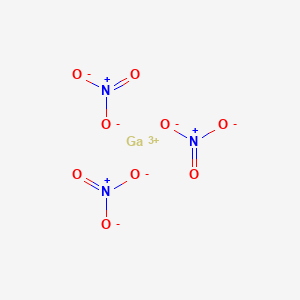



1. Gallium Nitrate
2. Gallium Nitrate Heptahydrate
3. Gallium Nitrate, 67ga-labeled
4. Ganite
5. Nsc 15200
1. Gallium Nitrate
2. 13494-90-1
3. Gallium Nitrate Anhydrous
4. Gallium Nitrate (anhydrous)
5. Y2v2r4w9tq
6. Nitric Acid, Gallium Salt (3:1)
7. Gallium(iii) Nitrate Solution, Ga 9-10% W/w
8. Ccris 4493
9. Nitric Acid, Gallium(3+) Salt
10. Einecs 236-815-5
11. Unii-y2v2r4w9tq
12. Mfcd00011016
13. Galliumnitrate
14. Gallium Nitrate [mi]
15. Dtxsid0043923
16. Gallium Nitrate [who-dd]
17. Gallium Nitrate (ga(no3)3)
18. Nitric Acid, Gallium Salt, Anhydrate
19. Akos015902357
20. Db05260
21. Sr-01000944456
22. Sr-01000944456-1
23. Gallium (iii) Nitrate, Solution Ga 9-10% W/w, Aldrichcpr
| Molecular Weight | 255.74 g/mol |
|---|---|
| Molecular Formula | GaN3O9 |
| Hydrogen Bond Donor Count | 0 |
| Hydrogen Bond Acceptor Count | 9 |
| Rotatable Bond Count | 0 |
| Exact Mass | 254.88903 g/mol |
| Monoisotopic Mass | 254.88903 g/mol |
| Topological Polar Surface Area | 189 Ų |
| Heavy Atom Count | 13 |
| Formal Charge | 0 |
| Complexity | 18.8 |
| Isotope Atom Count | 0 |
| Defined Atom Stereocenter Count | 0 |
| Undefined Atom Stereocenter Count | 0 |
| Defined Bond Stereocenter Count | 0 |
| Undefined Bond Stereocenter Count | 0 |
| Covalently Bonded Unit Count | 4 |
For the treatment of hypercalcemia. Also intended for the treatment of non-hodgkin's lymphoma.
Gallium nitrate exerts hypocalcemic effect by inhibiting calcium resorption from bone, possibly by stabilizing bone matrix, thereby reducing increased bone turnover. Gallium nitrate inhibits the growth of various lymphoma cell lines in vitro and exhibits antitumor activity in patients with lymphoma. The mechanism(s) of cytotoxicity is (are) only partly understood but appears to involve a two-step process: (1) targeting of gallium to cells, and (2) acting on multiple, specific intracellular processes. Gallium shares certain chemical properties with iron; therefore, it binds avidly to the iron transport protein transferrin. Transferrin-gallium complexes preferentially target cells that express transferrin receptors on their surface. Expression of transferrin receptors is particularly high on lymphoma cells. Cellular uptake of the gallium-transferrin complex leads to inhibition of cellular proliferation primarily via disruption of iron transport and homeostasis and blockade of ribonucleotide reductase. Recent studies have shown that cellular uptake of gallium leads to activation of caspases and induction of apoptosis. In phase II trials in patients with relapsed or refractory lymphoma, the antitumor activity of gallium nitrate is similar to, or better than, that of other commonly used chemotherapeutic agents.
Calcium-Regulating Hormones and Agents
Hormones and molecules with calcium-regulating hormone-like actions that modulate OSTEOLYSIS and other extra-skeletal activities to maintain calcium homeostasis. (See all compounds classified as Calcium-Regulating Hormones and Agents.)
Antineoplastic Agents
Substances that inhibit or prevent the proliferation of NEOPLASMS. (See all compounds classified as Antineoplastic Agents.)
Route of Elimination
Gallium nitrate is not metabolized either by the liver or the kidney and appears to be significantly excreted via the kidney.
Clearance
0.15 L/hr/kg [cancer patients receiving daily infusion of gallium nitrate at a dose of 200 mg/m2 for 5 or 7 days]
Alpha: 1 hour. Beta: 24 hours, but lengthens to 72 to 115 hours with prolonged intravenous infusion.
Gallium nitrate is believed to exert a hypocalcemic effect by inhibiting calcium resorption from bone. Gallium nitrate localizes preferentially where bone resorption and remodeling is occurring, and inhibits osteoclast activity. Inhibition of resorption may occur via a reduction in increased bone turnover. It seems to enhance hydroxyapatite function, inhibit osteocalcin, and inhibit the vacuolar ATPase on the osteoclast ruffled membrane. All these aid in the reduction of bone resorption.
